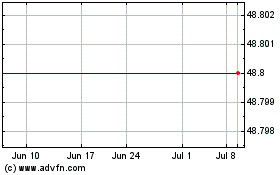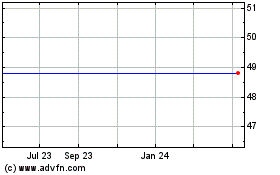By Rebecca Smith
Large U.S. utilities are joining forces to stockpile critical
pieces of electrical equipment that can be rushed to power
companies if they are hit by terrorist attacks, earthquakes or
other disasters that could cause extended blackouts.
Leading electricity companies including American Electric Power
Co., Exelon Corp. and Southern Co. are helping fund the creation of
a new Delaware company, Grid Assurance LLC. It will store circuit
breakers, large transformers and other crucial parts at secure,
unidentified locations, and sell them to participating utility
companies who need them during emergencies.
Meanwhile, Congress is contemplating the creation of a national
Strategic Transformer Reserve because it is also worried about
electric industry vulnerabilities.
Grid Assurance hopes to begin selling subscriptions to its
service this spring. The cost -- not yet determined -- will depend
on how many utilities join and how much equipment is purchased.
Participating utilities would buy equipment, at the original cost,
following disasters.
The venture underscores the growing concern in the utility
sector and government about coordinated attacks and natural
disasters that could cripple parts of the country's electric
grid.
In April 2013, unidentified gunmen stood outside an electrical
substation near San Jose, Calif., and shot up 17 transformers
funneling electricity to Silicon Valley. The transformers were
damaged but not destroyed.
Nevertheless, the incident spread fear that attacks on multiple
substations could unleash lengthy power outages that would cripple
other services, such as water treatment and police and fire
response.
"High voltage transformers are of particular concern because
they are vulnerable to attack, both from within and from outside
the substation where they are located," said a 2012 report on power
grid vulnerabilities from the National Research Council, which
advises Congress on scientific and technical matters.
"The industry has made some progress toward building an
inventory of spares, but these efforts could be overwhelmed by a
large attack," it concluded.
Currently, several dozen utilities share information with each
other about spares they have on hand, but there is no federal
requirement that they share equipment.
While all utilities keep replacement equipment, some parts, such
as spare transformers, typically sit close to where they may be
needed because they can weigh more than 500,000 pounds. That makes
them vulnerable to being damaged alongside the equipment in use, in
an attack or a natural disaster.
"The last thing we want is for someone to do a physical attack
and wipe out our spares, too," said Scott Moore, vice president of
transmission engineering for American Electric Power.
Many electric power components are hand-built, manufacturing
capacity is limited, and ordering them anew requires waits of up to
18 months. While that is acceptable for routine replacement, since
the gear often lasts 30 years or more, it is too slow for an
emergency.
That is why participants in Grid Assurance, who also include
Eversource Energy (formerly Northeast Utilities) and Edison
Transmission LLC, a unit of Edison International, are trying to
jointly stockpile needed parts.
The participants estimate they will need at least 100
transformers, often costing $2 million to $10 million each, so the
venture will be expensive, but far less costly than a major
blackout.
Ratepayer impacts are uncertain but likely will be minimal
because utilities already spend billions of dollars a year on
routine maintenance, the participants said. The utilities hope the
service will be fully functional by January 2018.
The Federal Energy Regulatory Commission last month swept away
some regulatory hurdles, allowing the program to proceed.
At the behest of Congress, the Energy Department is creating a
plan for a national strategic transformer reserve. A provision
tacked onto a major transportation bill, which passed in December,
requires DOE to study the need, analyze supply-chain problems and
develop a comprehensive plan by the end of the year.
David Ortiz, deputy assistant secretary for energy modeling and
analysis at DOE, said federal planning "is going gangbusters." No
money has been appropriated to buy equipment, though.
American Electric's Mr. Moore said he thinks industry and
government efforts can complement each other and needn't be
competing.
Grid Assurance backers say they are hard at work, too.
"We've been spending a lot of time developing the value
proposition," said Steven Eisenberg, president of Edison
Transmission. He said the greatest challenge may be persuading
utilities to pay for a service that amounts to catastrophic
insurance.
(END) Dow Jones Newswires
April 07, 2016 20:58 ET (00:58 GMT)
Copyright (c) 2016 Dow Jones & Company, Inc.
Exelon (NYSE:EXC)
Historical Stock Chart
From Mar 2024 to Apr 2024

Exelon (NYSE:EXC)
Historical Stock Chart
From Apr 2023 to Apr 2024
